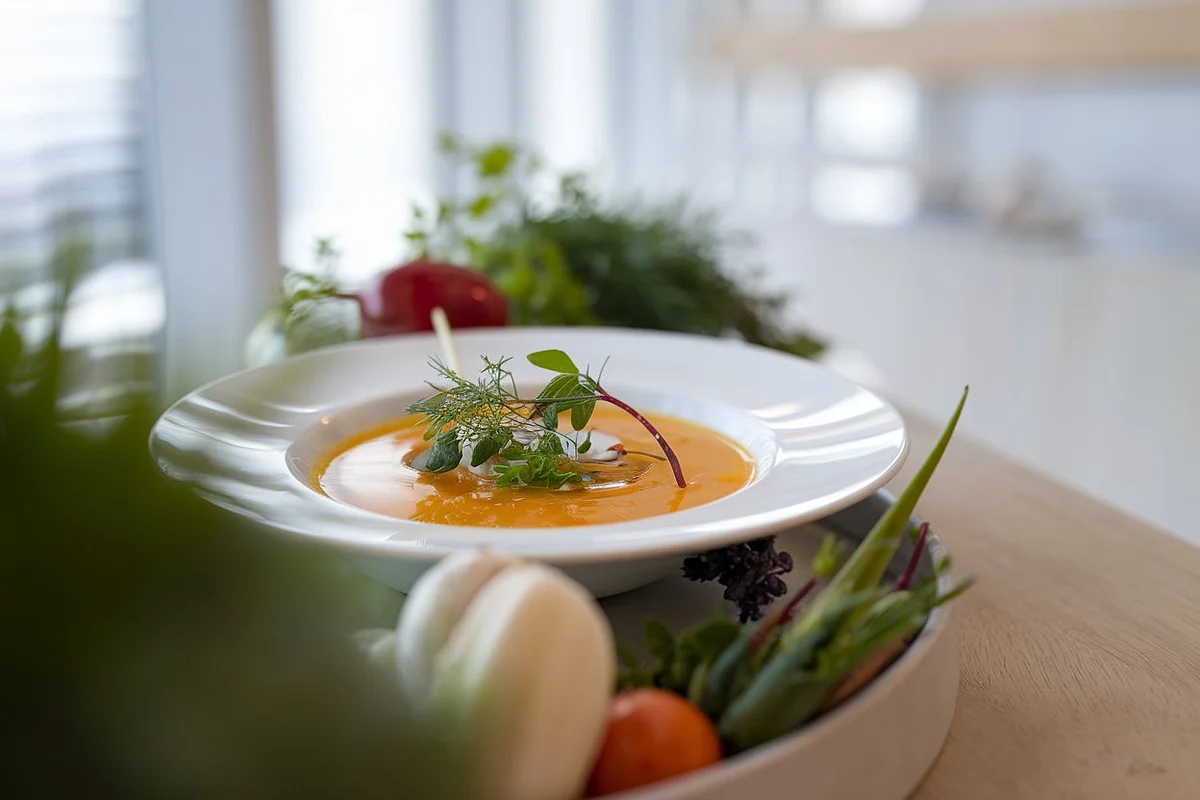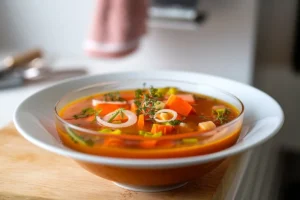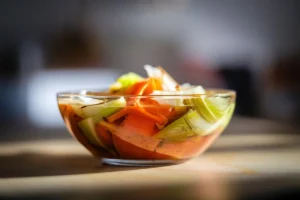Clear soup ranks among the most basic yet essential dishes across many culinary traditions worldwide. What is considered a clear soup? It’s a light, nutritious, and transparent broth, often recommended for its simplicity and health benefits. Whether you’re recovering from an illness, trying to lose weight, or simply craving a comforting meal, clear soups are a go-to choice.
In this article, we’ll explore clear soup, its variations, how to make it, the health benefits, and clear up some common misconceptions. Let’s dive into the fascinating world of clear soups!
What Is Considered a Clear Soup?
A clear soup consists of a broth that you strain to remove any solid ingredients, resulting in a transparent liquid. Typically, it’s made by simmering meat, vegetables, or bones in water until the flavor fully infuses the liquid. After simmering, you remove any solids to create a clear broth.
Some common types Considered of clear soup include:
- Consommé: A refined and flavorful soup clarified to achieve a crystal-clear liquid.
- Bouillon: A simple broth made by simmering meat, bones, or vegetables.
- Broth: Similar to bouillon, though this term often refers to a variety of light, clear soups.
- Japanese Clear Soup: Often called suimono, a simple soup made with dashi broth.
These soups are enjoyed across cultures, appreciated for their lightness and their role as an accompaniment to heavier dishes or as standalone meals.
Types of Considered of clear soup:
Clear soup comes in many forms, each with its own preparation style and ingredients.
1. Consommé
Chefs prepare consommé by clarifying broth or stock with egg whites. The egg whites bind with impurities and solids in the broth, and as they rise to the surface, the cook skims them off, leaving behind a crystal-clear liquid. This process results in a soup that not only looks clear but also delivers intense flavor.
- Commonly served in gourmet dishes, consommé boasts a refined texture.
- It can be made from beef, chicken, or vegetable broth.
2. Bouillon
Bouillon refers to broth in French, typically created by simmering meat, vegetables, or bones. Unlike consommé, bouillon doesn’t require clarification. Cooks often use it as a base for sauces, soups, and stews.
- People season bouillon with herbs like thyme or parsley.
- Bouillon cubes offer a concentrated, convenient version of this broth.
3. Broth
Broth involves simmering meat, vegetables, or bones, much like bouillon. However, it may contain small bits of the original ingredients and isn’t always as clear as consommé. It’s an essential component in many cuisines, offering a rich, savory flavor.
- It’s used in light soups and as a base for other dishes.
- Broth can come from various meats like chicken, beef, or seafood.
4. Japanese Clear Soup
Known as Suimono, Japanese clear soup typically uses a simple dashi broth. This broth is made from kombu (kelp) and katsuobushi (dried bonito flakes). Japanese restaurants often serve it before sushi or alongside other meals.
- It has a delicate, umami flavor.
- Typical garnishes include tofu, mushrooms, or scallions.
5. Dashi
Dashi forms the base for many Japanese dishes and soups, including miso soup. Made from kombu and katsuobushi, it provides a light, umami-rich flavor that complements a variety of ingredients.
- Dashi is quick to prepare and highly versatile.
- Many Japanese soups rely on this foundational broth for depth of flavor.
Easy Clear Soup Recipe
Health Benefits of Clear Soup
Clear soups carry several health benefits, making them a popular choice in medical and dietary settings. Here are a few reasons why:
- Low in Calories: Since clear soups mostly consist of broth and water, they contain fewer calories, making them ideal for those aiming for weight loss.
- Hydration: Clear soups are an excellent source of hydration, which is especially useful when you’re sick or recovering from surgery.
- Easy Digestion: Because they’re light and easy on the stomach, clear soups are often prescribed to people recovering from illness or medical procedures.
- Nutrient-Rich: Despite being low in calories, clear soups can pack a punch of vitamins, minerals, and amino acids—particularly if made with bone broth or nutrient-rich vegetables.
Clear Liquid Diet Guidelines
Cultural Variations of Clear Soup
1. Asian Clear Soups
In many Asian countries, clear soups play a vital role in everyday meals. For instance, Japan’s dashi is used in suimono and other light broths. In China, people consume bone broth and herbal soups for their purported health benefits. In Vietnam, the famous pho showcases a clear broth flavored with herbs and spices.
2. European Clear Soups
Europe, particularly France, has a rich tradition of clear soups. The French classic pot-au-feu features a clear broth with meat and vegetables. In Germany, chicken broth often serves as a base for lighter soups with dumplings.
3. American Clear Soups
In America, chicken noodle soup is perhaps the most iconic clear soup. Made with simple chicken broth, vegetables, and noodles, this dish is widely considered a go-to comfort food, especially for those feeling under the weather.
How to Make Clear Soup
Making clear soup at home is easy, as long as you use fresh ingredients and allow the broth to simmer long enough for the flavors to develop fully. Here’s a simple guide to preparing clear broth.
Basic Ingredients clear soup:
- Water
- Vegetables (onions, carrots, celery)
- Meat or bones (optional)
- Herbs (thyme, parsley, bay leaves)
- Salt and pepper
Preparation Steps :
- Simmer Ingredients: Place the ingredients in a large pot and cover with water. Bring it to a simmer. Keep the heat low to extract the flavors slowly.
- Skim the Surface: As the soup simmers, impurities and foam will rise to the surface. Skim them off to ensure the broth stays clear.
- Strain the Broth: After simmering for 1-2 hours, strain the broth through a fine sieve or cheesecloth to remove any solids.
- Season: Add salt, pepper, and herbs to taste. Your clear soup is now ready to serve.
Pro Tips:
- Roast the bones before simmering them for a richer flavor.
- Add garlic or ginger to enhance the soup’s aroma and taste.
Common Misconceptions About Clear Soup
People often misunderstand Considered
clear soups, so let’s clear up a few common misconceptions Considered:
- Is Miso Soup a Clear Soup?: No, miso soup contains miso paste, giving it a cloudy appearance. It doesn’t qualify as a clear soup.
- Are Thickened Broths Clear Soups?: No. Clear soups are always unthickened. Adding a thickening agent like cream or flour makes it a different type of soup.
- Is Ramen Broth a Clear Soup?: Only some ramen broths are clear. Many are cloudy due to fats and oils, so only the clear variety, usually made with dashi, qualifies as a clear soup.
Clear Soup vs. Miso Soup
While clear soups and miso soup often share the spotlight in similar settings, they have distinct differences.
- Ingredients: Clear soups use only broth, while miso soup includes miso paste, tofu, seaweed, and other ingredients.
- Flavor: Clear soups deliver a light, mild flavor, whereas miso soup has a stronger, more pronounced taste from the fermented miso.
- Usage: You typically serve clear soups as light appetizers or hydration aids, while miso soup serves as a more substantial dish.
FAQs About Clear Soup
1. What are examples of clear soups?
Examples include consommé, bouillon, broth, Japanese clear soup (suimono), and dashi.
2. Is miso soup a clear soup?
No, miso soup isn’t clear because of its miso paste, which makes it cloudy.
3. What is the difference between broth and consommé?
Broth is a simple clear soup made by simmering ingredients, while consommé undergoes a clarification process to remove impurities, resulting in a crystal-clear soup.
4. Can I have clear soup before a colonoscopy?
Yes, clear soups are often recommended as part of a clear liquid diet before medical procedures like colonoscopies.
5. Is ramen broth considered a clear soup?
Not all ramen broths qualify as clear. Only those made with dashi or light stocks fall into the clear soup category.
Clear Soup Recipes
Here are some simple, tasty clear soup recipes you can try at home:
1. Basic Consommé
- Ingredients: Ground meat, egg whites, broth, mirepoix (onions, carrots, celery)
- Method: Simmer the ingredients, clarify with egg whites, and strain for a clear, flavorful soup.
2. Vegetable Clear Soup
- Ingredients: Onions, carrots, celery, leeks, parsley
- Method: Simmer the vegetables, strain the broth, and season with salt and pepper.
3. Chicken Broth
- Ingredients: Chicken bones, onions, garlic, thyme, bay leaves
- Method: Simmer the chicken bones and aromatics, strain, and serve hot.
Clear Soups in Diets and Medical Contexts
Clear soups hold significant importance in medical diets, especially before surgeries or during recovery.
- Clear Liquid Diet: Doctors often recommend clear liquids, including clear soup, before procedures like colonoscopies.
- Post-Surgery Recovery: Due to their gentle nature on the stomach, clear soups are an ideal choice for those recovering from surgeries.
- Weight Loss and Detox: Because they are low in calories and help with hydration, clear soups are often part of detox diets and weight-loss programs.
Conclusion
In conclusion, clear soups are versatile, healthy, and enjoyed in various forms worldwide. From the luxurious consommé to the simple yet flavorful broth, clear soups offer something for everyone. They’re easy to make, packed with health benefits, and can be customized to fit various dietary needs. Whether you’re recovering from an illness or simply looking for a light, nutritious meal, clear soups are an excellent choice.



